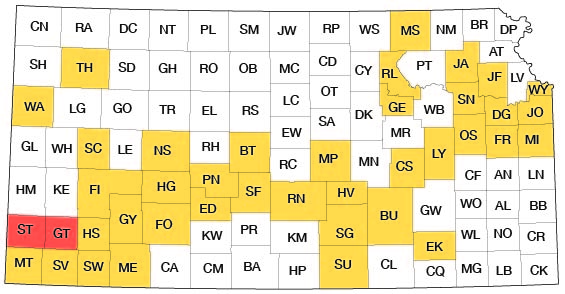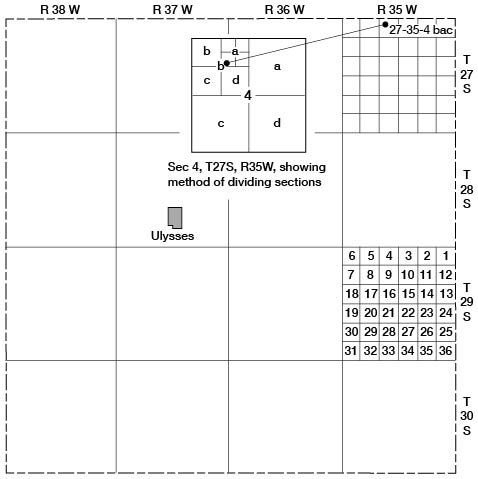Prev Page--Contents || Next Page--Geography
Introduction
Purpose and Scope of the Investigation
Large quantities of ground water are available in western Kansas for agricultural, municipal, domestic, and industrial purposes. In 1960, 131,000 acre-feet of ground water was withdrawn in Grant County and 128,000 acre-feet was withdrawn in Stanton County for all purposes. About 98 percent of the water was used for irrigation.
A reconnaissance of the water levels in southwestern Kansas by the Kansas Water Resources Board in January 1958 showed a considerable decline of water levels since 1944 in small localized areas. The reconnaissance indicated that a more comprehensive study of the geology and hydrology of the area was needed to provide adequate information for the future development of the area and to provide a basis for sound planning for future use.
A study of the ground-water resources of southwestern Kansas was begun in August 1958. Because the area is vast and the hydrologic and geologic problems are complex. it was decided to limit the study to Grant and Stanton counties (the most intensively developed areas) for the first report. Objectives of the investigation included: a geologic study of the water-bearing materials, a study of the hydrologic properties of the water-bearing materials, information on water levels, water-level contour maps, movement of ground water, an estimate of the amount of water in storage, data on the chemical quality of the ground water, and information on phreatophytes.
This investigation is a part of a systematic study of the ground-water resources of Kansas begun in 1937. This cooperative program is being conducted by the U. S. Geological Survey, the State Geological Survey of Kansas, the Division of Water Resources of the Kansas State Board of Agriculture, and the Environmental Health Services of the Kansas State Department of Health. The water programs in Kansas are coordinated by the Water Resources Board. The present status of the ground-water investigations in Kansas is shown in Figure 1 [...].
Figure 1--Index map of Kansas showing area described in this report and areas covered by other online geologic reports, as of July 2007. For additional information, please visit the KGS Geologic Maps of Kansas Page.

Description of the Area
Grant and Stanton counties are in the southwestern part of the State (Fig. 1). The combined area of the two counties is 1,260 square miles. The population of Grant and Stanton counties combined was 7,361 in 1960, according to the U. S. Census Bureau [In 2005, Grant was at 7,530 and Stanton at 2,245, KU Institute for Policy and Social Research]. The area is in the Cimarron Unit, as described by the Kansas Water Resources Board in their State Water Plan Studies (1`58).
Previous Investigations
The geology and ground water of southwestern Kansas was briefly discussed by St. John (1887) and by Hay (1890). A more detailed study was made by Haworth (1897a, 1897b, and 1897c), with emphasis on ground water in the Dakota and younger formations. Johnson (1901, 1902) made special reference to the source, availability, and use of ground water in western Kansas. The ground-water conditions in the area were briefly described by Parker (1911) in a report on the chemical quality of water supplies in Kansas. Additional ground-water studies were made by Haworth (1913).
The first detailed studies of the geology and ground-water resources of this area which included the northern parts of Grant and Stanton counties, were by Darton (1920). The geology of Hamilton County and the northern part of Stanton County was described by Bass (1926). Theis, Burleigh, and Waite (1935) made a reconnaissance of the ground-water resources of the High Plains. A study of the Neogene geology of southwestern Kansas was made by Smith (1940).
The cooperative studies of the ground-water resources of southwestern Kansas which were started in 1937 were published as bulletins by the State Geological Survey of Kansas as follows: Latta (1941), McLaughlin (1942, 1943, 1946), and Frye and Fishel (1949). Frye and Leonard (1952) made a study of the Pleistocene geology of Kansas and outlined the Pleistocene drainage patterns. Merriam and Frye (1954) investigated the Cenozoic of western Kansas and included a map showing the areal geology and topography of the surface below the Cenozoic deposits. Merriam (1957) made a correlation of the Mesozoic rocks in Kansas which included a cross section through Stanton County. The Kansas Water Resources Board studied the water resources of the area (KWRB. 1958) as part of their preliminary appraisal of Kansas water problems.
Prior to 1956, water-level measurements in selected observation wells throughout the State were published annually in water-supply papers published by the U. S. Geological Survey. Since that time, water-level data have been published annually in bulletins of the State Geological Survey of Kansas.
Methods of Investigation
The collection of field data on which this report is based was begun in August 1958 and was continuous through July 1960. Intermittent field work was continued until January 1963. Previous geologic maps were used as a guide to map the surface geology.
The study of the subsurface geology utilized the samples from 94 test holes and 342 drillers' logs. Logs of the test holes were prepared in the field and revised as the cuttings were examined in the office. Samples of cuttings from test holes and wells were glued onto strip logs for easy comparison of the lithology. Electric or radioactivity logs when available were traced on the strip logs to supplement and to compare with the sample logs. All the electric and radioactivity logs in the files of the State Geological Survey obtained from oil and gas tests in the Grant-Stanton area were examined. Most of these logs did not show the geologic section above the Permian rocks. However, 47 of these logs which did show some or all of the section above the Permian were used in the geologic study. Fossils from 14 wells and 2 outcrops were studied for use in the geologic correlations.
Information was obtained during the inventory of 814 wells concerning the depth to water, depth of the well, diameter, use, and interval perforated. The drillers' logs of these wells were obtained when available. All altitudes were determined by and tied into bench marks of the U. S. Geological Survey and the U. S. Coast and Geodetic Survey.
Aquifer tests were made at 26 well sites to determine the hydrologic characteristics of the water-bearing materials. All tests utilized an irrigation well as the pumped well and, where available, other irrigation wells were used as observation wells. Observation wells were drilled at six sites to obtain drawdown information. All the pumped wells for these tests were perforated in more than one aquifer. The data obtained from these tests were used to analyze the water-level contour maps.
Twenty-six samples of water were collected from representative wells. The samples were analyzed in the Sanitary Engineering Laboratory of the Kansas State Department of Health under the direction of Howard A. Stoltenberg, Chief Chemist. In addition, complete analyses of water from 63 wells have been retabulated from previous reports. Two hundred five partial analyses of water samples from wells are also included. These analyses were examined in an attempt to correlate water quality with the various aquifers.
Well-Numbering System
The well and test-hole numbers used in this report give the location of wells and test holes according to the General Land Office Surveys and according to the following formula: township, range, section, quarter section, quarter-quarter section, and quarter-quarter-quarter section (10-acre tract). The subdivisions of a section are designated a, b, c, and d in a counter-clockwise direction beginning in the northeast quarter. If several wells or test holes are in a 10-acre tract, they are numbered serially after the above letters and in the order in which they were inventoried. (Fig. 2).
Figure 2--Map of Grant County illustrating well-numbering system based on land-classification system.

Acknowledgments
The writers wish to thank the owners of the wells for their cooperation and especially those who permitted the use of their wells for aquifer tests. Acknowledgment is given Guy Vincent, Water Commissioner, Division of Water Resources, Kansas State Board of Agriculture, and his staff for their cooperation in supplying well information and water levels, and for help in conducting aquifer tests. W. Lockwood, U. S. Geological Survey, was assigned to this project from its inception until June 1960 and did much of the preliminary geologic field work. Well logs and other information were supplied by the following well drillers and drilling companies: Juel Water Well Drilling Company; Ray Stevenson; Henkle Drilling and Supply Company, Inc.; Kenny Minter; C. K. Minter Drilling Company; Swearengen Water Well Company; Loucks Brothers Drilling Service; Western Drilling Company: Ray Stagner; Arnold Drilling Company: and Dreiling Drilling Company. The Liberal Geological Society and oil and gas companies in the area cooperated in furnishing deep-well information and allowing access to their test holes during drilling. Some altitudes were determined by a field party headed by D. R. Lee, Topographic Division; others were determined by a party headed by E. L. and C. L. Reavis. E. A. Waddell and W. A. Long compiled the tables of chemical analyses and well records.
Acknowledgment is given to A. B. Leonard and Tong-yun Ho, Zoology, Department, University of Kansas, for identifying the fossil mollusks, and to C. W. Hibbard, Curator of Vertebrates, University of Michigan, for identifying the micro-vertebrates.
The manuscript of this report has been reviewed critically by several members of the Federal and State Geological Surveys: by R. V. Smrha, Chief Engineer, and Harris Mackey. Engineer, Division of Water Resources. Kansas State Board of Agriculture: by W. O. Hilton, Geologist. Environmental Health Services, Kansas State Department of Health; by D. F. Metzler, Executive Secretary, Kansas Water Resources Board; and by R. L. Smith. Professor, School of Engineering, University of Kansas.
Prev Page--Contents || Next Page--Geography
Kansas Geological Survey, Geology
Placed on web July 17, 2007; originally published December 1964.
Comments to webadmin@kgs.ku.edu
The URL for this page is http://www.kgs.ku.edu/General/Geology/Stanton/02_intro.html